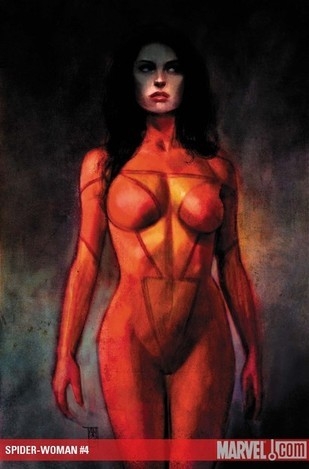Marvel Comics
Spider-Woman #4
By Zak Edwards
January 2, 2010 - 23:14
Marvel Comics
Writer(s): Brian Michael Bendis
Penciller(s): Alex Maleev
Letterer(s): Cory Petit
$2.99 US
So now that the fervor of the reuniting of Brian Michael Bendis and Alex Maleev, whose long-time, critically acclaimed run on Daredevil was used as a marketing point for this new series, has finished, it’s time to consider the series beyond the initial fanfare. The series has some questions to answer: does the series fill a purpose and maybe even a forgotten or required niche in the Marvel Comics line, is the character of Jessica Drew able to hold her own as the protagonist, and, most importantly, is the series any good? Yes, the bringing together of these two great creators is a good thing, but after name-dropping, what is this series up to?
In a nutshell, it seems to be up to not much. The first two issues of the series seemed to be simply loaded with information and scenes now no longer required as Bendis has relied more on the action sequence than the dramatic sequence. This issue and the last have been more focused on the titular character running around and punching (or running away and not punching) than any intrigue the series seemed to promise early on. One of the draws for me to this series was a combination of Bendis’ previously proven brilliance with the noir style of comic book and the fact he said Jessica Jones, the protagonist of his Alias series, was originally supposed to be Jessica Drew. Now that Bendis has Drew (and Maleev), this series seemed destined to succeed at least critically while occupying a noir space which is operating on a different level than Daredevil. The series seems to not really be able to decide what it is, and not in a genre-blurring sort of way, but in a hesitant experimental way I would not expect from such a seasoned team. The first couple of issues were certainly noir and espionage while the last two have been more reminiscent of a Die-Hard style of comic book. One could argue, as far as niches go, that noir is really taken care of in the Marvel line with Daredevil and things like former Daredevil writer Ed Brubaker’s Criminal and the espionage can be seen in the triumphant return of Nick Fury in Jonathan Hickman’s Secret Warriors, but Spider-Woman does seem to feel decidedly different from these initially while the action focus of the past two issues really work against this. Marvel Comics publishes enough inane violence every week without Spider-Woman. But the protagonist does offer a certain level of intrigue as seen in the initial sequence with her encounter with the Skrull. Honestly, at this point, Drew is the only thing keeping me tied to this book besides the art unless Bendis starts playing his strengths over emphasizing pointless action sequences. The level of decompression in this issue is frustrating, especially when the final five pages of Drew simply running are split up on every page by advertisements, all of which are for Marvel Comics or Marvel related endeavours. Reading this book reminds me of a TV movie where the advertising keeps going up and up until you barely get any content before switching back to ads. Same here, except by the end the content isn’t worth reading, emphasized by a two-page spread showing what a “true Skrull looks like” only a few months after the Secret Invasion event showed more ‘true’ Skrulls than really necessary. All this is unfortunate for a series with such promise.
As I said, Maleev’s art is one of the two reasons for a continued purchasing of this title. His art is dark and brooding with simply amazing colouring. The colours wash things out, bleed together, create crazy patterns and make the book much nicer to look at than read. Great examples of the colouring happen throughout the fight scene with the Skrull, where Maleev’s colours create a disorienting effect which draws the reader closer to the protagonist because of an implied subjectivity to the art. As Drew is knocked to the ground, the colours around her become white and mix with strange shapes and other colours. The panel doesn’t create a typical seen of a pure white backdrop, but actually puts the white at the front of a backdrop of a heavily distorted version of the actual background. The blood splatters on the subsequent pages are used to guide the eye through the dual page setup. The colouring is complex, adding dimensions to the story, which is something every artist should consider.
5/10 There’s hope yet, but the only strengths lie largely out of the writer’s hands while the art plays the redeeming role.
Related Articles:
Milo Manara's Spider-Woman
Spider-Woman #7
Spider-Woman #4
Spider-Woman #2
Spider-Woman #1
Today’s Special: Spider-Woman Motion Comic Still 99 cents.
Spider-Woman

